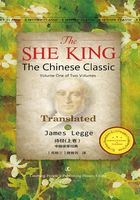
LUH E
1 Green is the upper robe,
Green with a yellow lining!
The sorrow of my heart,—
How can it cease?
2 Green is the upper robe;
Green the upper, and yellow the lower garment!
The sorrow of my heart,—
How can it be forgotten?

NOTE ON THE INTERPRETATION. Choo He, in his Work on the She, contends that we have in this ode the complaint of Chwang Këang, the wife of one of the marquises of Wei, because of the neglect which she experienced from her husband;—as will be explained on the next ode. He was preceded in the view that the subject of the ode was a lady by Han Ying and Lëw Heang; but they referred it to Seuen Këang, the circumstances of whose history, as related by Tso-she under the 11th year of Chwang, p. 5, and the 2d year of Min. p. 7, would not harmonize with the spirit of this piece. Choo, therefore, discarded her, adopted Chwang Këang, and argues at great length, in his notes on the'Little Preface', against Maou's view. His work on the She was published A. D. 1177; but in his work on the'Four Books', completed about 12 years afterwards,he seems to have returned to the view of the older school. See his remarks on the first two lines of st.4, in Mencius, VII. Pt. ii. XIX. Mencius at any rate,by applying those lines to Confucius, sanctions the view of the ode which regards it as the complaint of a worthy officer, neglected by his ruler, and treated with contempt by a host of mean creatures.
Ode 2. Metaphorical. THE COMPLAINT, SAD BUT RESIGNED, OF A NEGLECTED WIFE. We said that the last piece was explained by Choo of Chwang Këang, one of the marchionesses of Wei. This ode and several others are, by the unanimous consent of the critics, assigned to her, though it is only in ode 3 that we have internal evidence of the authorship, or subject at least, that is of weight.
The marquis Yang (楊), or duke Chwang (莊),succeeded to the State of Wei in B.C.756. In that year, he married a Këang, a daughter of the House of Ts'e,—the Chwang Këang of history. She was a lady of admirable character, and beautiful; but as she had no child, he took another wife, a Kwei (厲嬀) of the State of Ch'in. She had a son, who died early; but a cousin who had accompanied her to the harem, called Tae Kwei (戴嬀), gave birth to Hwan (完), whom the marquis recognized as destined in due time to succeed him. At his request, and with her own good will, Chwang Këang brought this child up as her own.Unfortunately, however, another lady of the harem,of quite inferior rank, bore the marquis a son, called Chow-yu (州吁), who became a favourite with him,and grew up a bold, dashing, unprincipled young man. The marquis died in 734, and was succeeded by his son Hwan, between whom and Chow-yu differences soon arose. The latter fled from the State;but he returned, and in 718 murdered the marquis, and attempted, without success, to establish himself in his place.—The above details we have from Sze-ma Ts'ëen, and from Tso-she under the 3d and 4th years of duke Yin. The odes lead us further into the harem of Wei, and show us the dissatisfactions and unhappiness which prevailed there.
St. 1,2. L1.1.2 'Yellow' is one of the 5 'correct'colours of the Chinese (see on Ana. X. vi.), and 'green'is one of the 'intermediate', or colours that are less esteemed. Here we have the yellow used merely as a lining to the green, or employed for the lower and less honourable part of the dress;—an inversion of all properly, and setting forth how the concubine,the mother of Chow-yu, had got into the place of the rightful wife, and thrust the latter down. The old interpreters take the lines as allusive, while with Choo they are metaphorical; but they understand them in the same way.

3 [Dyed] green has been the silk;—
It was you who did it.
[But] I think of the ancients,
That I may be kept from doing wrong.
4 Linen, fine or coarse
Is cold when worn in the wind.
I think of the ancients,
And find what is in my heart


